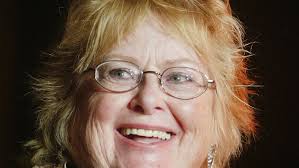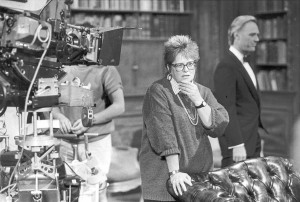 Cool September evenings heat up with New York Women in Film & Television (NYWiFT) events. I started my crazy fall season of film watching and writing on a select film festivals circuit with a Tuesday evening screening: There Were Times, Dear and a memorial tribute, more accurately, a celebration of the life of NYWiFT member, Nancy Malone. I didn’t know Nancy, but after the Women’s Film Preservation Fund (WFPF) committee’s decision to make this film, directed by Nancy, the first effort to preserve and restore a television program, I wanted to see the film and hear more about Nancy’s life and work. As the seats in the screening room at the Tribeca Film Center filled up, I knew this was going to be a special night with NYWiFT members and Nancy Malone’s family and friends.
Cool September evenings heat up with New York Women in Film & Television (NYWiFT) events. I started my crazy fall season of film watching and writing on a select film festivals circuit with a Tuesday evening screening: There Were Times, Dear and a memorial tribute, more accurately, a celebration of the life of NYWiFT member, Nancy Malone. I didn’t know Nancy, but after the Women’s Film Preservation Fund (WFPF) committee’s decision to make this film, directed by Nancy, the first effort to preserve and restore a television program, I wanted to see the film and hear more about Nancy’s life and work. As the seats in the screening room at the Tribeca Film Center filled up, I knew this was going to be a special night with NYWiFT members and Nancy Malone’s family and friends.
Through NYWiFT, I found out that she was an award-winning actor, producer and director in films, stage and television and the first woman to hold a departmental vice president role at a major studio and one of the original founders of Women in Film-Los Angeles (WIF-LA Chapter). In the 1980s, she directed her first television movie, There Were Times, Dear, starring Shirley Jones, Len Cariou (present at the screening), along with Dana Elcar and Gloria Stuart. It was the first movie made for television about Alzheimer’s disease that portrayed family members struggling with the physical and emotional trauma of identifying Alzheimer’s as a disease and not just a factor of growing old.
 Television in the 1980s focused on smaller selective audiences in response to cable stations showing movies that weren’t going to be on network television for months, even years. According to Britannica, through this new strategy–target marketing specific audiences–shows made for television were aimed at young, upscale and educated viewers. With literate, visually dense, narratives were complex, using language that sounded more like the movies than television, network television could aspire to be a serious dramatic art form. Network dramatic programming grew from a specialized form into a mainstream genre, competed with cable movie channel programming, who then followed the network model creating their own quality dramas. In the 1980s social realities and stories based on true events– precursors to reality television– were vast and plentiful.
Television in the 1980s focused on smaller selective audiences in response to cable stations showing movies that weren’t going to be on network television for months, even years. According to Britannica, through this new strategy–target marketing specific audiences–shows made for television were aimed at young, upscale and educated viewers. With literate, visually dense, narratives were complex, using language that sounded more like the movies than television, network television could aspire to be a serious dramatic art form. Network dramatic programming grew from a specialized form into a mainstream genre, competed with cable movie channel programming, who then followed the network model creating their own quality dramas. In the 1980s social realities and stories based on true events– precursors to reality television– were vast and plentiful.
The first practical professional broadcast quality videotape machines were capable of replacing kinescopes and filmstock. Videotapes recorded images and sounds onto magnetic tape and is a linear method of storing information. As the high cost of early videotapes ($300 per one-hour reel) often meant that most broadcasters erased and reused them, videotapes were regarded as a better and more cost-effective means of time-delaying broadcasts. They were fully expected to gradually lose all importance as non-linear/random-access methods of storing digital video data become more common. Many early videotapes no longer exist. Nancy knew this well. As a member of the Women’s Film Preservation Fund, she became an advocate for the restoration and preservation of television videotapes in danger of being lost forever
Alexis Alexanian, president of the New York Chapter introduced NYWiFT as a professional organization with over two thousand members and part of the Women in Film & Television International (WIFTI) network of women in film Chapters worldwide. The Women’s Film Preservation Fund is the only fund in the world that preserves and restores American films, from any era, in which women have held significant creative positions including, but not limited to, writer, director, producer, editor and performer.
Susan Lazarus, a founding member of the WFPF, recalled how Nancy was adamant in including television videotapes for preservation and restoration. At WFPF meetings, members known as “shepherds” take on certain projects and see them through, finding funders, brain-storming ways to fund raise, and connecting with media outlets such as Museum or Modern Art (MoMA), Film Society of Lincoln Center and Fort Lee Film Commission.
 Next to me, in the screening, a woman seated with her daughter asked me how I knew Nancy. I said I didn’t know Nancy, but I heard so much about her. As the program began, long time friend and co-producer with Nancy, Linda Hope, introduced Len Cariou, who spoke briefly. When the biographic photo montage played, I heard soft murmurs as the audience acknowledged Nancy’s early life, her Irish roots and many accomplishments from a childhood modeling start to mentorship programs. After the screening, I turned to the women next to me and asked how she knew Nancy– she seemed to react to every photo, especially to one of Nancy’s mother. “That was my grandmother,” she replied, “my father was Nancy’s oldest brother.” She added how she loved seeing the old photos of her family, what a wonderful aunt and mentor Nancy had been and now she wanted her daughter to see the strides Nancy made, what she worked on and believed in.
Next to me, in the screening, a woman seated with her daughter asked me how I knew Nancy. I said I didn’t know Nancy, but I heard so much about her. As the program began, long time friend and co-producer with Nancy, Linda Hope, introduced Len Cariou, who spoke briefly. When the biographic photo montage played, I heard soft murmurs as the audience acknowledged Nancy’s early life, her Irish roots and many accomplishments from a childhood modeling start to mentorship programs. After the screening, I turned to the women next to me and asked how she knew Nancy– she seemed to react to every photo, especially to one of Nancy’s mother. “That was my grandmother,” she replied, “my father was Nancy’s oldest brother.” She added how she loved seeing the old photos of her family, what a wonderful aunt and mentor Nancy had been and now she wanted her daughter to see the strides Nancy made, what she worked on and believed in.
A classy reception followed with small potted orchids adorning every table. Among the guests that told a “Nancy story” included the venerable Angela Lansbury who spoke about Nancy’s love for the Irish and her professionalism in showbiz, others followed, producers, associates, close friends and family (her niece, Sheila), a couple of best friends and protogee friendships she forged with younger female filmmakers. Last, but not least, Terry Lawler, Executive Director of NYWiFT, asked everyone to raise their glass for a toast to Nancy’s life. There was a flurry to fill glasses and when she spoke of her friend and fellow woman in film industry professional, her voice choked a little, but then followed by a chorus of cheers for Nancy. I didn’t know Nancy Malone, but I wish I did.
The Nancy Malone Marketing and Promotion Grant is given each year to a first-time woman director of a narrative feature for use when the film opens. The deadline is in the spring. Contact Elizabeth Estrada at 212-679-0870, ext. 39, or grants@nywift.org.



10/03/2014
NYWiFT